Contact us today:
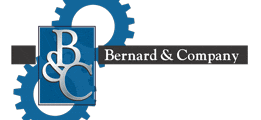
(847) 934-4500
tdaro@bernardandcompany.com

Contact us today:
(847) 934-4500
tdaro@bernardandcompany.com
FOREST CITY GEAR EXPANDS BLANKING DEPARTMENT
Leading gear manufacturer acquires three new Haas turning centers to produce “donuts” for its gearmaking operations

Forest City Gear’s blanking department now boasts a Haas ST-10 and two ST-20 Turning Centers. These machines were acquired recently to improve the throughput at Forest City Gear, a world leader in fine- and medium-pitch gear and spline work. The machines are used primarily for production of “donuts”, the near net blanks used in the company’s gearmaking operations.
Roscoe, IL-Forest City Gear has acquired three Haas turning centers to improve the throughput at its gearmaking facility. The company has made this investment, according to President Wendy Young, “…because we needed to better control our throughput and reduce the time to start up jobs. We were experiencing some severe delays from outside vendors and we saw problems on the horizon from such bottlenecks. Our company is always on the lookout for such conditions, because both our quality and our delivery protocols are vital to our success with current and potential customers in the world market.” These new machines will be used in the company’s Blanking Department, headed by Tommy Kalt, who detailed the new machines.
“We purchased a Haas ST-10 Turning Center with a magazine bar feeder, 300 PSI high-pressure coolant system and automatic tool presetter. It’s a fast, very flexible and very easy-to-use machine tool.” This machine, as well as two Haas ST-20 Turning Centers with 8” chuck and 20-station hybrid turret, fully programmable tailstock and high-pressure coolant pump, are currently operating in the Forest City Gear facility to produce “donuts” from automatically fed bar stock. These donuts are the near net shape blanks used in the gearmaking operation here. As a custom producer of extremely tight tolerance gears for the most demanding applications, according to company CEO Fred Young, “We need to have optimum control of our operation, at every step. Our company today exports gears to every corner of the world and our rigorous quality standards require a number of intermediate steps, prior to shipment. If the blanks are not available and our production is delayed, the entire operation slows and we simply will not allow that to happen,” Young stated emphatically.
Kalt expands on the ST-10. “It has a manual, programmable tailstock for shaft work, another real advantage in 
On the business side, Wendy Young was very satisfied with the cooperation of the Haas sales and delivery team. “We were treated fairly and the support has been first-rate, right from the start. We already see the benefits of this purchase to our company.”
For more information on this story, please contact: FOREST CITY GEAR CO., INC. 11715 Main Street Roscoe, IL 61073-0080 Phone: 815-623-2168 Fax: 815-623-6620 Web: www.forestcitygear.com
Email: wyoung@forestcitygear.com Attention: Wendy Young, President
PR agency contact for Forest City Gear: Tim Daro Bernard & Company 847-934-4500 tdaro@bernardandcompany.com
Continue readingDuring the upcoming GIFA 2011 show in Dusseldorf, Germany, Magma will present its new software generation for casting process simulation, MAGMA5. At the 300 sq. m stand 12A16, the company will demonstrate how casting process simulation with MAGMA5 can be used for optimization at all stages of casting manufacturing to contribute to foundry profitability. MAGMA will show the newest version MAGMA5 5.2 with extended capabilities for all cast materials and processes, introduce its new software MAGMA C+M for the simulation of the core production processes and provide a view into the future of autonomous optimization of casting processes. Additionally, MAGMA is participating in the initiative “ecoMetals” from the Messe Düsseldorf, which supports companies who develop innovative products and processes leading to a more efficient use of energy. MAGMA will demonstrate, using practical examples, how the application of casting process simulation considerably increases a foundry’s energy and resource efficiency.
MAGMA5 – optimized simulation
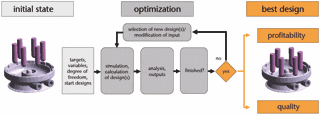
Autonomous optimization of casting processes and layouts, shown here for gating optimization in die casting, is the future of casting processsimulation.
MAGMA5 5.2 introduces several new simulation capabilities: new process modes for permanent mold, low pressure sand and low pressure die casting, as well both hot-chamber and cold-chamber die casting, allow for detailed process-specific definitions. The software also supports process design by controlling process parameters during a simulation run. For gravity casters, process modules for DISAMATIC and investment casting are now available.
At GIFA, MAGMA will also present its newest developments for the quantitative prediction of as-cast and heat treated local microstructures and properties in aluminum, iron and steel castings. MAGMA5 simulates sand and reoxidation inclusions during mold filling and predicts defects related to molding materials. MAGMAnonferrous calculates the final microstructure and mechanical properties for aluminum alloys considering the metallurgy, inoculation, and hydrogen content of the melt. MAGMAiron predicts local microstructures for iron materials from graphite growth through to the distribution of phases making up the matrix. MAGMAsteel calculates macrosegregation in steel castings and the local microstructure resulting from heat treatment.
The stress module MAGMAstress for the first time offers casters the option to calculate thermally induced casting stresses in permanent molds for all manufacturing steps, including heat treatment and finishing, in order to predict casting crack problems and distortion. The simulated distortion results can be evaluated just as on a coordinate measuring machine and compared directly with real measurements. For the first time, the new module MAGMAdielife facilitates the evaluation of the effects of tooling design and thermal stresses on the durability of permanent molds.
MAGMA Core+Mold – transparency in core production
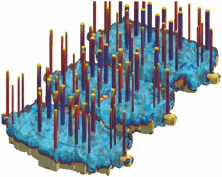
With MAGMA C+M, the simulation of the core shooting process is possible for complex tools, shown here for three cores including blow tubes in a single core box.
With MAGMA C+M, MAGMA introduces an integrated tool for the simulation of core production processes. MAGMA C+M simulates core shooting, blowing and hardening of organic and inorganic cores. Processes where binder hardening is driven by a catalyst gas as well
as core production with tempered core boxes are supported. MAGMA C+M considers all aspects of core production starting from the core shooter, in order to calculate the flow of the air-sand mixture based on the real shot parameters. An integrated database provides the ability to specify the characteristics of the sand and the binder system as well as core box vents and blow tubes. The program simulates gassing, purging and the curing reaction of gas-hardened cores. The design and control of core box tempering for heat-cured cores (hotbox, croning, inorganic) is effectively supported by modeling of heating cartridges and oil channels. For inorganic cores, MAGMA C+M calculates the drying of the core in the heated core box as well as due to transport of water vapor by hot air during gassing. MAGMA C+M takes advantage of all the functionality of MAGMA5 and is available as an add-on module to MAGMA5 or asa stand-alone product.
Autonomous optimization is the future
With autonomous optimization, foundrymen can make use of simulation in order to pursue their objectives for quality and cost. Autonomous optimization makes proposals for the right casting layout or the optimum process parameters. The virtual test foundry in the computer enables variation of parameters and systematic examination of influencing variables leading up to the optimum configuration. Based on the fundamental physics embedded in MAGMA5, the program finds the best possible dimensions and positions of ingates, as well as the location of feeders and chills including their optimum size. Using industrial examples, MAGMA will present state-of-the-art capabilities and provide a view into the future of optimization.
MAGMA – very involved
At the accompanying WFO Technical Forum, MAGMA will give presentations on the topics of aluminum casting, core production, and optimization. At the NewCast exhibition, which takes place in parallel with GIFA, simulation specialists will discuss the prediction of residual stresses and distortion in cast iron components.
MAGMA also has a further exhibition stand (12A15) as part of the “Get-In-Form” project “Youth-Technology-Future” (“Jugend-Technik-Zukunft“). Here, the attractiveness of work as a professional or specialist in the metal casting industry will be illustrated to students and apprentices in an entertaining and interactive manner.
About software for casting process simulation
Casting process simulation software considers the complete casting process including mold filling, solidification and cooling, and also provides the quantitative prediction of mechanical properties, thermally induced casting stresses and the distortion of cast components. Simulation accurately describes a cast component’s quality upfront before production starts, thus the casting layout can be designed with respect to the required component properties. This results in a reduction in pre-production sampling, but also the precise layout of the complete casting system leads to energy, material and tooling savings for the foundry.
The range of application of MAGMA solutions comprises all cast alloys, from cast iron to aluminum sand casting, permanent mold and die casting up to large steel castings. The software supports the user in component design, the determination of melting practice and casting methodology through to mold making, heat treatment and finishing. This saves costs consequently along the entire casting manufacturing line.
During the last 10 years, the use of casting process simulation has become a valuable business asset for many foundries. MAGMA5 now expands the capabilities of casting process simulation and will further accelerate the acceptance of this technology.
About MAGMA
MAGMA offers comprehensive solutions to the metal casting industry, casting buyers and casting designers worldwide. The MAGMA product and service portfolio includes the powerful modular simulation software MAGMASOFT®,with the newest release MAGMA5, as well as engineering services for casting design and optimization.
Today, MAGMASOFT® is used throughout the metal casting industry, especially for the optimization of cast components in automotive and heavy industry applications.
MAGMA Giessereitechnologie GmbH was founded in 1988 and is headquartered in Aachen, Germany. A global presence and support are guaranteed by offices and subsidiaries in the USA, Singapore, Brazil, Korea, Turkey, India and China. Additionally, more than 30 qualified partners represent MAGMA around the world.
For more information on this release, please contact:
Christof Heisser President MAGMA Foundry Technologies, Inc. 10 N. Martingale Road, Suite 425 Schaumburg, IL 60173 Phone 847-969-1001 ext. 225
Email: cheisser@magmasoft.com Web: www.magmasoft.com
Agency contact: Tim Daro Bernard & Company 847-934-4500 tdaro@bernardandcompany.com
Continue reading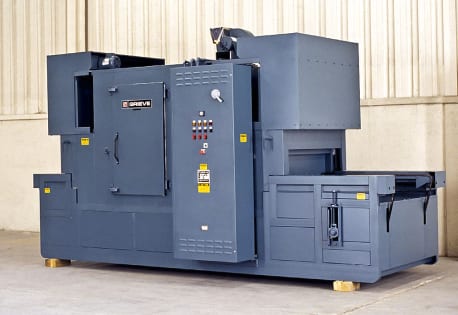
The oven has 5” insulated walls and an aluminized steel interior and exterior. It features three zones: 2’ long open belt loading zone, 7’ long insulated heat zone with recirculated airflow and 4’ long open unloading zone. The mandrels holding product move through the oven on two strands of 60 pitch roller chain on 35” centers, powered by a ¼ HP motor drive with fixed speed of 32 inches per minute.
A 4200 CFM, 3-HP recirculating blower provides vertical downward airflow to the workload, while a 325 CFM powered forced exhauster is also onboard. Motor operated vertical lift doors are provided at each end of the oven.
Controls onboard No. 874 include SCR power controller and fused disconnect switch. A PLC controls temperature and conveyor indexing.
For more information, please contact:
THE GRIEVE CORPORATION
500 Hart Road
Round Lake, IL 60073-2898
Phone: (847) 546-8225
Fax: (847) 546-9210
Web: www.grievecorp.com
Email: sales@grievecorp.com
Attention: Frank Calabrese, VP
13-year-old student visits Forest City Gear to explore career options; meets many women already succeeding in “a man’s world”
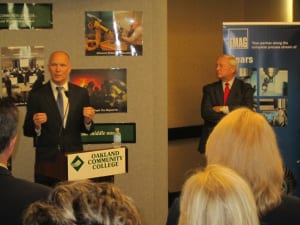
Accompanied by her grandfather, Brian Cluff, vice president of Star-SU, a major gearmaking machinery and tooling supplier, Alexi Cluff toured Forest City Gear to see the manufacturing world and discuss the options there for young women. Alexi, though only 13, is currently enrolled in an advanced engineering class at Northern Illinois University, designed to encourage more young women to explore engineering and science as a career.
Roscoe, IL-Forest City Gear frequently opens its doors to visitors, usually from customer and prospect companies, as well as international trade associations, the media, vendors and occasionally competitors. Company owners Fred and Wendy Young have always believed this policy was beneficial to the visitors, who see some of the industry’s finest gearwork, produced and validated for quality on absolute state-of-the-technology, world-class equipment.
On March 30, 2011, however, another visitor came to tour Forest City Gear with a slightly different agenda. 13-year-old Alexi Cluff, accompanied by her grandfather Brian Cluff, vice president of Star-SU, a leading supplier of gearmaking machinery and tools, visited Forest City Gear to learn about manufacturing and especially to explore the options for women in manufacturing, an environment traditionally thought to be “a man’s world.”
Alexi is not your typical 13-year-old. She is currently enrolled in a program sponsored by a grant from the Motorola Foundation and conducted at the College of Engineering and Engineering Technology at Northern Illinois University. The program is a workshop in partnership with NIU-Enhanced Engineering Pathways, the Society of Women Engineers and the Girl Scouts of Northern Illinois. The stated objective of the program is to challenge and sharpen the skills of accelerated learning for 12- and 13-year-old girls selected by their local middle school science and math teachers. Currently, 48 girls work in small groups, assisted and taught by NIU women engineering professors and women engineers from various industries. These instructors mentor the girls on various engineering projects, from the building of simple electrical circuits to create sound, motion and light, to bridge building, chemical engineering and lean manufacturing simulation. The groups meet on Saturday mornings on the NIU Napervillie (IL) campus and also attend a summer camp, held each June.
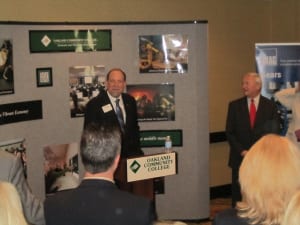
Forest City Gear President Wendy Young conducts the tour through the plant, showing Alexi Cluff the many types of machines used to produce and validate quality on the company’s high-precision gearwork.
Often, the groups or individual students have tours arranged for them at local area manufacturing locations such as electronics and communications giant Motorola, where they can absorb “real world” experiences and especially meet women of all ages who have succeeded in the various disciplines required in a manufacturing environment. Since Alexi’s grandfather had a long working relationship with Forest City Gear, he reached out to Fred and Wendy Young to arrange a tour. The Young’s obliged, giving the young lady a complete tour of their factory and quality lab, plus arranging a roundtable discussion with a number of the women at the company, who perform all categories of activity for Forest City Gear. A world leader in precision gear manufacturing, Forest City Gear has an international reputation for “excellence without exception,” which happens to be the motto of the company.
Women from all departments of the company, including application engineering, human resources, gear grinding, gear deburring, gear hobbing, order processing, estimating, expediting, procurement, materials inspection, quality validation, machine set-up and company management were at the table. Alexi’s eyes and ears were wide open, as she listened attentively to every word.
Seated at the table for Forest City Gear, in addition to Wendy Young, president, were Kika Young, Geneva Parr, Mary McClellan, Krista King, Sharyl Stewart, Lori Lovett and Ingrid West. These women are involved in literally every aspect of the company. As Mary McClellan mentioned, “We touch the products at every step of the process, especially me (in gear deburring), because of my little fingers!” These women were unanimous in their advice to Alexi Cluff. “Always be willing to learn more, never be afraid to speak up with your ideas, bring all your skills to the job, every day, and don’t hesitate for ask for directions…something men never do!” They all had a good laugh.
Alexi said, “I’ve always been interested in making things and finding out how they work,” a sentiment her grandfather echoed. “I started making gears when I was 14 and it’s fascinated me, ever since.” If there’s anything to that old adage about the genes skipping a generation, perhaps the gear industry will have another Cluff in its future!

Forest City Gear CEO Fred Young explains some of the company’s gear successes to Alexi Cluff at the company’s display showcase.
At the end of the roundtable, Forest City Gear CEO Fred Young had some comments. He detailed the difference in the European education model, where there’s considerably more encouragement given to young women to explore any and every working option. In America, he noted, “Our greatest strength came from manufacturing, the basic ability to make things better and faster than anybody else. The value-added service of making something from raw materials is what builds a nation’s wealth and makes us more self-reliant. Letting go of manufacturing would be a big mistake. By learning and using the technology we develop, as well as what we can gather from other countries, we’ll make America a stronger nation and more successful, in the long run.”
Following the visit, her grandfather remarked to Forest City Gear President Wendy Young, “Alexi was excited and, on the way home, quite animated. The sharing time with your ladies impressed her immensely. She has been journaling her observations. She told us in the car on the way back home that the very first class she had at the NIU workshop for girls was a hands-on exercise in lean simulation and that what she saw at Forest City Gear, from the way the routing sheets, bar codes and processing were set up, that you obviously have implemented lean manufacturing practices! As she downloads, processes and articulates what she saw and observed, she has already started to ask me questions about gear geometry. Such sweet candy to this old grandpa!”

At this roundtable discussion, Alexi Cluff listened as women from every department of Forest City Gear spoke of their roles at the company and the many opportunities for women in the traditional “man’s world” of manufacturing. Many of these women are the lead or key individual in their respective departments at the company.
In reviewing the NIU program and the comments above, perhaps it’s possible Alexi Cluff actually IS your typical 13-year-old girl. They just need to be shown their options.
Forest City Gear was founded in 1955 by Stetler and Evelyn Young, parents of the current CEO, Fred Young, who runs the company with his wife, President Wendy Young. Forest City Gear is considered among the premier gearmakers in the worl
d, with successes ranging from the Mars Rover to the BMW/Oracle, winner of the America’s Cup.
Brian Cluff and his longtime colleague and partner, David Goodfellow, manage and operate Star SU LLC, located in Hoffman Estates, IL. The company sells various leading brands of gearmaking machinery, other machine tools and a proprietary line of cutting tools.
Here is a link to the news release about the program on the NIU-EEP website (www.niu.edu/eep): http://www.niu.edu/PubAffairs/RELEASES/2008/nov/scouts.shtml
For more information on this story, please contact: FOREST CITY GEAR CO., INC. 11715 Main Street Roscoe, IL 61073-0080 Phone: 815-623-2168 Fax: 815-623-6620 Web: www.forestcitygear.com Email: wyoung@forestcitygear.com Attention: Wendy Young, President
PR agency contact for Forest City Gear: Tim Daro Bernard & Company 847-934-4500 tdaro@bernardandcompany.com
Continue reading
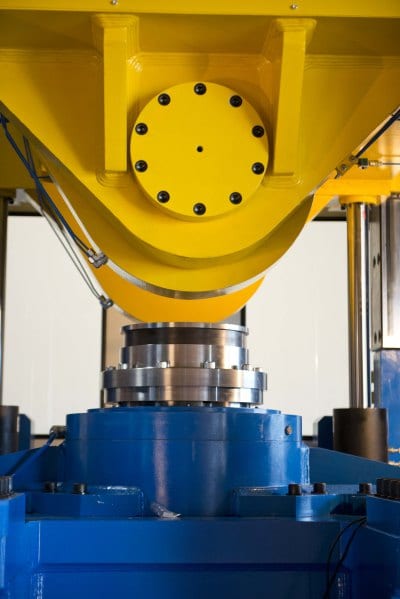
MC726/MT-2C machining center from Stama America; 30% smaller footprint than conventional mill/turn centers
Allows six-sided processing of parts in two independent operations in five axes on single machine; twice the speed of conventional MT centers with 30% less footprint
Stama America, Itasca, Illinois announces the introduction of its MC 726/MT-2C mill/turn, twin spindle machining centers for the automotive, fluid power, tooling, medical and other industries, where parts needs to be milled and turned in production operations. This new machining center is the latest iteration of the popular TANDEM concept mill/turn centers, introduced by Stama in 2007.
Two independent spindles are onboard, each on a traveling column assembly and each supporting an independent swivel table, one of which acts with a bar feeder mechanism. Workpieces are introduced to the turning spindle, then transitioned by a conveyorized gripper assembly to the milling indexer and fed to the milling spindle, before finally exiting the work area.
Complete six-sided machining is possible between the two cutting operations, all on one machine with approximately twice the speed of a conventional m/t center in 30% less footprint. Since the first part is being milled simultaneously to the next part being turned, the overall production operation is greatly enhanced, nearly doubling in many applications.
For more information on this new machining center, please visit our website or contact:
STAMA AMERICA
1063 Hawthorne
Itasca, IL 60143
Phone: 630-233-8101
Fax: 630-773-1660
Web: www.stama-america.com
Attention: Simon Knecht, Sales Engineer
Simon.knecht@stama-america.com
GM realizes “weeks to hours” reduction in line change and transmission build dynamics at Toledo Powertrain, resulting from Flexible Assembly Configuration System (FACS) and Siemens control/communication
A tried and true euphemism nowadays, “thinking outside of the box” usually refers to a pattern of thought or action that results in rapid innovation, enhanced relationships being developed from established concepts as well as new ones, plus a genuine willingness to forego past practices in favor of a better way. Enter the GF6 six-speed, front wheel transmission line at General Motors Powertrain on Alexis Road in Toledo, Ohio.
Here, a new front wheel drive transmission line for smaller, more fuel efficient vehicles such as the popular Chevy Malibu and new Chevy Cruze is currently ramping up to its initial goal of 2200 units per day. Nothing new about such an event, until a closer look reveals the method used to program this line, implement changeover, stage the workpiece flow, perform all machining, secondary operations and assemble the finished transmissions.

Greg Nazareth, GM controls engineer, demonstrates the reconfiguration procedure on the FACS server, part of the overall Flexible Assembly Configuration System, provided by Elite Engineering of Rochester Hills, Michigan.
During the development of this line, several years ago, GM engineering contacted its longtime controls suppliers to investigate ways of significantly reducing the workflow through the line, as well as enable faster changeover, reduce reprogramming and prevent the curse of all automated manufacturing lines, situations where one out-of-spec machine caused complete shutdown. Another key driver in the development of the GF6 line was the need to minimize maintenance time by installing PLCs, drives and component pallet recognition devices outside the conventional cabinetry found on traditional assembly lines. In addition, controllers were distributed throughout the system, which allowed for removal of typical zone controllers and, in turn, substantially increased system flexibility.
Following considerable investigation into the process for the new line, the major obstacle remained changeover and the need for a more flexible yet highly automated system of transmission builds. In consultation with the controls provider on the existing six-speed, rear wheel drive line, Siemens Automotive Center of Competence (Troy, Michigan), as well as third party software package provider, Elite Engineering (Rochester Hills, Michigan), a deterministic study was undertaken and the result was the line now in production. Siemens provided the PLC, CNC, HMI, RFID and its high-level Ethernet protocol, Profinet, to run on the GM network. Overlaying this hardware and communications topology, Elite Engineering delivered its Flexible Assembly Configuration System (FACS), complemented by Siemens to create its SIFACS solution, wherein all the control elements for every assembly operation and test stations would be fully integrated. SIFACS largely focuses on the integration of the core PLC software blocks and functionalities of the individual stations with the RFID tags on each of the workpiece pallets, according Jim Remski, manager of powertrain activities for Siemens.

Siemens CNC and HMI technology combine with its Profinet high-level Ethernet communications and RFID pallet tags to execute the machining, assembly and testing at this transmission plant, currently targeting an output of 2200 units/day.
AN INTEGRATED APPROACH
Within any flexible automated assembly system, the keyword is flexible. All hardware and related software must be designed with a deterministic functionality that is both valuable to the customer’s build strategy and cost-competitive, as well. Working with technical specialists in safety integrated systems and industrial communications alike was the key to the success of this project at GM Toledo. By creating a decentralized control network that was nonetheless in complete harmony with the overall workflow of the plant, GM and Siemens devised the optimum modular yet flexible architecture for the entire system. This totally integrated automation approach not only addressed multiple families of hardware involved, it also coordinates all code development, safety and communications functions into a seamless and interdependent yet highly flexible and adaptive control scheme.
This integration is nowhere more visible than in the modular and open controller and I/O rack assemblies located throughout the facility. A Siemens Simatic® S7 CPU, the Siemens Safety Integrated drives platform and all I/O, including RF antennas for RFID tag reading are configured and reside here.
Diagnostics in the system are similarly integrated, according to Matthew Thornton and Jeremy Bryant, who consulted from Siemens. “We devised pre-made templates and blocks important to the powertrain build process, as our starting point,” commented Thornton, who further noted the importance of placing the critical performance data on all the HMI panels in the system for easy operator access. “With all motion and safety functions integrated into the drives, there was no need to build a separate troubleshooting architecture for what would be a more traditional safety network of relay cabinetry.”
Bryant continued, “Only a few components talk on the Profibus system, all other I/O and automation components communicate over Profinet.
Reinhold Niesing of the Siemens Automotive Center of Competence further explained the contact process between his group and the provider of the FACS. “They provided the configuration and monitoring system, while we (Siemens) provided the automation run time system. Both systems needed to run in sync to provide GM with configurable options, when changes in production or manufacturing enhancements were needed.”

Each RFID tag carries all the information needed to produce the part at each of the machining and assembly stations in the line.
The result of this collaboration, coordinated under the Siemens Transline solution, whereby all operational, visualization and diagnostic functions are streamlined in a consistent control scheme, was the Transline HMI Lite CE package. This package provides uniform user interface for operational and diagnostic functions on the vast majority of the various machine tools, transfer lines, robotics, assembly machines, sensing devices and vision systems throughout the entire facility. As Michael Grass, project manager for Siemens, explains, “The best part is that the package can be customized to meet specific user needs and preferences. It provides our SIFACS (see sidebar) system of configurable assembly automation very useful information, as the two systems complement each other quite well.” In the safety communications area, he also noted that GM is currently reviewing another Siemens option for open safety communications technology on distributed automation systems.
RFID GETS THINGS STARTED
As a workpiece proceeds through the line, having been delivered by an AGV in most cases, each pallet is equipped with an RFID tag. Reinhold Niesing, engineering manager on the project for Siemens, explains, “The key here is the data throughput in the system, as it directly impacts the cycle time or takt time (maximum allowable time to produce one finished part or product) of the line. The tags must be able to function in static mode, whereby the data on the part must be read before the process begins. Model number, serial number and build status information are all contained in the tag. The faster we read the information, the faster the process begins.” Niesing also detailed the dynamic mode of operation for this RFID system, in which the information at subsequent line stations must be read “on the fly” without any line stoppage, as is often seen in conventional packaging, shipping or other line applications for RFID. In this case, all data are read as the tag passes by the antenna.
Often, in less sophisticated applications, the signal can degrade over time and number of reads. Here, according to the Siemens technical specialists, two interface protocols are supported, namely, ISO 15693 (open standard) and a proprietary Siemens-developed standard, Simatic RF300. The latter uses a state-of-the-art chip paired with highly optimized communications to achieve the faster data read/write rates. Large amounts of data (64kB) are handled in faster cycle times, while the overall RFID solution is applied in a high-speed, non-stop environment. One of the key drivers in the system is the fact that each RFID tag has both EEPROM and FRAM. The 20-byte EEPROM is actually designed to be a one-time programmable memory chip (OTP), a security feature that was deemed most desirable by GM for this application. Meanwhile, the FRAM can be written and rewritten many times for optimum utilization of the hardware, over time.
Despite this level of sophistication in the RFID hardware, the system easily communicates over the existing Profinet, Profibus and other common protocols.
LOGIC BLOCKS ALL AROUND
The overall thrust of the line development, according to George Jewell, the GM engineer responsible for the implementation of the FACS online at the Toledo plant, was to have consistent, even identical logic blocks at every station. This would allow, as is seminal to the FACS architecture, immediate successive modifications to be made in the machine or assembly operations performed, throughout all stages of the line. When rebalancing was needed, when an upturn/downturn in current production was required or when an entirely new model came onto the line, the changeover needed to happen in hours, rather than in weeks, as was the industry norm.
By standardizing on the hardware, software and communication protocols used, engineering costs could be contained and, as a collateral but vital side effect, maintenance on the system could be made much more efficient with much of the system hardware exposed on the line, rather than enclosed in electrical cabinets, again the norm for the industry in the past. Flexible modules would allow more rapid reconfiguration, product changes and a genuine synergy with the ongoing GM commitment to continuous improvement in the line, as the new GF6 transmission ramped up to incremental target levels of production.
Jewell noted that Siemens responded to the challenges, “…with a plug-and-play technology approach, coupled with an understanding of the processes we utilize.”
From the utility perspective, he also noted that the run-time component in the system would function without the full configuration system being online, further complementing a decentralized architecture. Bob Raven, GM controls manager, further commented, “The Siemens commitment to provide this value added functionality geared towards flexibility within our manufacturing principles has substantially supported GM Powertrain’s efforts to standardize processes, controls and continuously improve.”
Currently, GM uses the FACS at various plants in Mexico, China, India, Thailand, Korea and the U.S. — and soon in Canada and Eastern Europe, for the production of transmissions, engines and even the generator on the new Chevy Volt. These products, it should be noted, can be manufactured, assembled and tested, all within the same flexible control architecture, while supporting standardized GM processes.
Rather than textbook product life cycle management, Jewell sees FACS as more of a production line life cycle management tool, as its inherent adaptability means common hardware can be made to do diverse tasks, at varying rates, with on-the-fly changeover, in far less time than previously possible.
TYPICAL STATION DYNAMICS
On one automated assembly station, Hanwha produces the various sub-assemblies of the transmission, as other lines produce the components that go into the sub-assemblies. Adding a station, as Greg Nazareth, GM controls engineer, explained, requires simply adding a PLC with the standard SIFACS logic, desired process devices and downloading an eFACS configuration. In contrast to the traditional zone control, this reconfiguration is not a building block concept; rather, the instructions being given impact the entire line. Nazareth worked with the full GM controls team, headed by Ron Goeckerman, to implement FACS with the host server.
By contrast, all manual workstations on this line have the same download received to a PLC, provided by Siemens in its Simatic lines. While not reliant on the server network in a deterministic mode, the manual stations nonetheless utilize the same software to execute quick tooling changes, machine sequence variations, line balancing and report tracking. Operators received training from both Siemens and Elite Engineering personnel for these tasks.
All part build histories, troubleshooting and machine debugging are recorded for further analysis.
CONTROLS CALL THE BALL AT EVERY STEP
Throughout the metalcutting process here, mostly in the gear and spline forming, hobbing, grinding and finishing, CNC technology is onboard dozens of machine tools. Most of the machines here are controlled by Sinumerik® 840D, the highest-level CNC offered by Siemens. The control not only processes the particular part dimensions in the cutting theater of the machine, it also coordinates all motion control and movements into and out of the machine. Working in tandem with the other hardware and communication network software in the line, for example, ring gears cut on a Wera Profilator machine are indexed from one station to the next, in timed sequences, to coordinate with predetermined production requirements. This operation occurs in a fully automated mode, requiring no operator intervention, except for maintenance and planned inspections.
Likewise, in the machining of valve bodies and transmission cases, each step of the process is controlled by the Siemens CNC to produce the required components in the proper sequence for subsequent assembly and testing operations. During those subsequent operations, other motion control devices and software solutions provided by Siemens execute, monitor and control the assembly process, through the SIFACS solution set. (See sidebar.)
PROFINET TALKS THE TALK
Through a decentralized and cabinet-less design, GM achieves highly integrated RFID control with easy access and true out-of-the-box solutions for the control architecture installed on this line. A Profinet solution provides GM with a high-performance, reliable network with minimum bandwidth impact or additional network load achieved at this plant, all with no special hardware required, a further cost savings for GM.
SAFETY FIRST — AND LAST
Safety features are numerous here, resulting in a complete failsafe system across all Siemens Simatic PLC, I/O devices and safety-integrated drives. All safety devices are networked over Profisafe protocol, a certified safety network, eliminating time-consuming and difficult to maintain traditional hardwired safety connections. All safe I/O, failsafe drives are part of the Siemens Totally Integrated Automation (TIA) protocol. Since it is fully integrated, this protocol provides comprehensive system diagnostics,

Rear wheel drive, six-speed line has been in full production, while the new line is producing front wheel drive, six-speed transmissions for vehicles such as the Chevy Malibu and new Cruze models.
which can help guide maintenance staff to exact fault location and mitigate downtime. Since the drives, starters and machine safety are integrated into the multi-functional machine mount I/O system, Simatic ET 200pro, the overall engineering complexity is reduced because of simplicity in panel design, wiring architecture and seamless integration to the project level hardware configuration, which is reduced due to the totally integrated automation design. For service requirements in the event of a fault, hot swapping of an I/O module is possible during operation, without switching off the entire station. There is nonetheless a very high degree of integral protection, to IP65/67 standards. The fact that an enclosure is not required also helped save on the total cost of the project for GM.
MAJOR INVESTMENT PAYING OFF
Between the two lines here, GM Toledo has invested $872 million on its six-speed, rear- and front-wheel drive transmission production at this 2 million square-foot facility, which currently employs 1400 employees, most members of UAW Local 14.
The highly fuel-efficient rear-wheel drive Hydra-matic 6L80 transmission is now joined by the GF6 front-wheel drive, six-speed
units being produced on this new line under the FACS control solution that supports flexible manufacturing while driving standard processes.
As George Jewell, the GM engineer who spearheaded the implementation of FACS, stated, “From our first installation in Ramos Arizpe (Mexico) to this Toledo plant, we’ve seen great results, with activities that took months reduced to weeks and what took weeks reduced to hours. There’s less ramp-up time, plus the changeover and line balancing upsides are already proving this was a beneficial investment.”
Please direct all inquiries generated by this story to:
John Meyer
Siemens Industry, Inc.
Marketing Communications
390 Kent Avenue
Elk Grove Village, IL 60007
Phone: 847-640-1595
Fax: 847-437-0784
Email: SiemensMTBUMarCom.sea@siemens.com

Wera Profilator gear profiler run by a Sinumerik 840D, the highest level CNC in the Siemens line, used for fully automated production of ring gears.
SIFACS — THE SIEMENS SOLUTION FOR THE FLEXIBLE ASSEMBLY CONFIGURATION SYSTEM (FACS)
Working in tandem with GM process specialists and Elite Engineering, the third party provider of the unique Flexible Assembly Configuration System (FAC
S) used at this GM Toledo transmission plant, Siemens personnel created SIFACS, a solution that integrates the host IT system at the facility with all hardware and software in the line.
SIFACS is quite literally the hub of the information management system for this line, as it coordinates all demand input from the GM server and FACS configuration stations, transmits it via the Profinet communications network in the plant to all the onboard PLC, HMI, motor starters, frequency converters, safety-integrated drives and other controls at the various machine tool, assembly and test stations.
Likewise, the feedback data from all RFID, smart sensors, RS-232 interfaces, hand scanners and other I/O devices are tracked and captured for detailed analysis by production management here.
In this way, not only is the system’s production output closely controlled, but also the line stations themselves can be reconfigured, using a unique Siemens micro memory card that allows easy component replacement, without a laptop. All PLC logic, hardware configuration and process data are embedded on the card, which is interfaced to three Ethernet and one Profibus ports for instant communications.
Critical for a continuous moving line such as those found here, the Siemens Simatic control systems are executing motion commands read from the RFID devices at 8000 bytes/sec, far in excess of the ISO 15693 standards for read and write performance.
SIFACS HMI screen extensions with Cognex Vision View further permit constant monitoring by both a team leader and a conveyor controller, eliminating a PC dedicated to a vision system.
All the smart devices on the line are also interfaced to the SIFACS solution, including fastening, leak test and pressing systems, plus barcode readers, barcode printers, robotic articulation and handling devices, vision systems and protocol gateways.
eFACS functionality is finally integrated into the SIFACS, as this feature of the Elite Engineering system provides connection establishment and monitoring, as well as configuration, process and status data exchanges, plus management of the model configuration data, all stored on the system.
On the most practical of levels, even the data structures feed to the Andon boards for in-plant display is integrated through the resident IT system via SIFACS.
Process Improvement Tools and Process Efficiency Tools, provided with the FACS, enable both process and production engineers to collect data and fine tune the system in real time, keeping build status and cycle time information always current. Line and station balancing can likewise be achieved on-the-fly, with complete process efficiency, operator loading, anticipated cycle time, even individual process operation time calculations being made, charted, displayed and rapidly analyzed by the team leader or station control personnel, in a hierarchy of need-to-know, need-to-act protocol.
The net effects of the Siemens SIFACS® system and the Elite eFACS are sustainable, highly flexible production scenarios, coupled with lower life cycle costs, as the controls and station hardware need not be re-invented for each new model, as well as lean manufacturing strategies, since the line can be constantly tuned without interruption. The flexibility, data analysis and transparent metrics of these systems further allow all employees to understand the current line performance in real time and to make suggestions for improvements that can be implemented almost immediately.
“It’s a win-win-win for all parties involved,” commented George Jewell of GM, whose team pioneered the development and application of these systems for his company’s various plants. Further advancements in FACS and SIFACS are currently being introduced at other GM facilities worldwide, according to Jewell.
For additional product information and inquiries:
SIEMENS INDUSTRY, INC.
DRIVE TECHNOLOGIES
MOTION CONTROL
MACHINE TOOL BUSINESS
390 Kent Avenue
Elk Grove Village, IL 60007
Phone: 847-640-1595
Fax: 847-437-0784
Web: Email: SiemensMTBUMarCom.sea@siemens.com
Attention: John Meyer, Manager, Marketing Communication
Follow us on Facebook: www.facebook.com/SiemensCNC or Twitter: www.twitter.com/siemens_cnc_us.
—
Siemens Industry Sector is the world’s leading supplier of innovative and environmentally friendly products, solutions and services for industrial customers. With end-to-end automation technology and industrial software, solid vertical-market expertise, and technology-based services, the sector enhances its customers’ productivity, efficiency and flexibility. With a global workforce of more than 100,000 employees, the Industry Sector comprises the Industry Automation, Drive Technologies and Customer Services Divisions as well as the Metals Technologies Business Unit. For more information, visit http://www.usa.siemens.com/industry.
The Siemens Drive Technologies Division is the world’s leading supplier of products, systems, applications, solutions and services for the entire drive train, with electrical and mechanical components. Drive Technologies serves all vertical markets in the production and process industries as well as the infrastructure/energy segment. With its products and solutions, the division enables its customers to achieve productivity, energy efficiency and reliability. For more information, visit http://www.usa.siemens.com/drivetechnologies.
Continue readingCHICAGO — During this year’s IMTS, Siemens raffled off a 10th anniversary motorcycle built by Orange County Choppers (OCC), the custom build shop owned by Paul Teutel 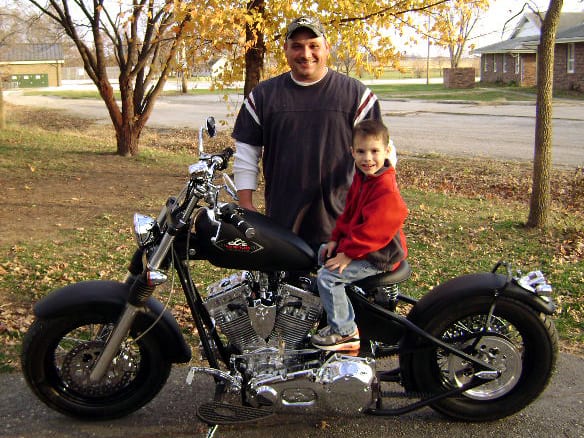
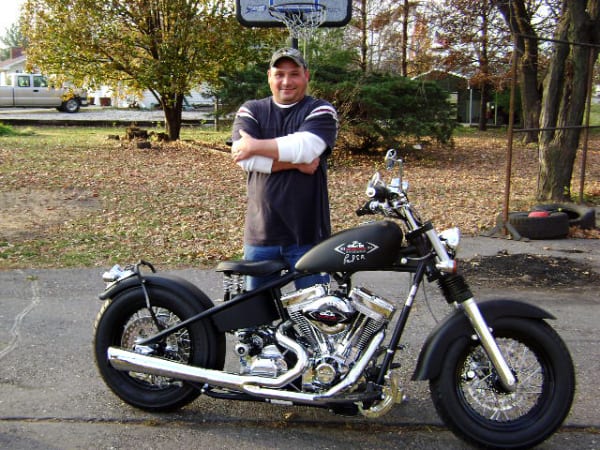
The winner was Bob Pool, machining supervisor at Riverview Manufacturing Inc., located in Palmyra, Missouri and a division of Doyle Equipment Manufacturing Company, across the Mississippi River in Quincy, Illinois. Doyle is a major manufacturer of dry bulk handling machinery and Riverview fabricates large-capacity fertilizer spreaders and other equipment for its parent company.
As Bob tells his story, “I’d gone to IMTS with a colleague from Riverview and we noticed the crowd at the Siemens booth. We were waiting in a very long line to get our picture taken with Paul Teutel from Orange County Choppers and the nice young lady who was registering us asked if we wanted to sign up to win the motorcycle. I’d ridden bikes all my life but never owned one. I figured I’d take the chance, but didn’t think about it much, after signing up. The photographer said the photos would be up at the website a couple days later and, when I checked, I couldn’t find them, so I called Siemens. The next morning, I came into the shop and saw a message from Siemens. I called and asked about the photos and got steered to the right spot on the website, but the person said he was really calling for another reason. To my surprise, he said I’d won the bike!”
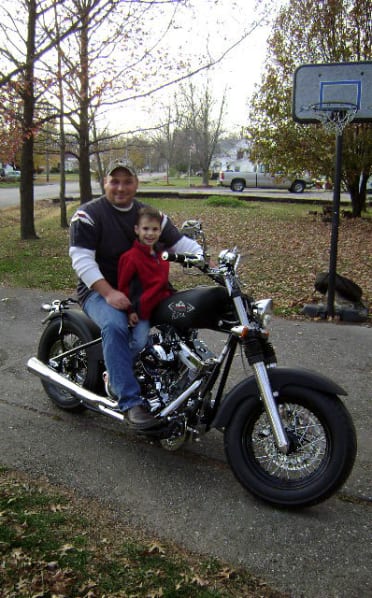
Riverview is a 25-person shop with full CNC machining, welding and assembly capabilities, all used to produce the 6- and 8-ton spreaders and other Doyle brand equipment built here. Bob says he looks forward to taking very good care of his new bike and using it for many years to come. “I’m really enjoying it and am sure glad I stopped by the Siemens booth at IMTS!”
For more information:
SIEMENS INDUSTRY, INC.
DRIVE TECHNOLOGIES
MOTION CONTROL
MACHINE TOOL BUSINESS
390 Kent Avenue
Elk Grove Village, IL 60007
Phone: 847-640-1595
Fax: 847-437-0784
Web: www.usa.siemens.com/cnc
Email: SiemensMTBUMarCom.sea@siemens.com
Attention: John Meyer, Manager, Marketing Communication
Follow us on Facebook: www.facebook.com/SiemensCNC or Twitter: www.twitter.com/siemens_cnc_us.
—
Siemens Industry Sector is the world’s leading supplier of innovative and environmentally friendly products, solutions and services for industrial customers. With end-to-end automation technology and industrial software, solid vertical-market expertise, and technology-based services, the sector enhances its customers’ productivity, efficiency and flexibility. With a global workforce of more than 100,000 employees, the Industry Sector comprises the Industry Automation, Drive Technologies and Customer Services Divisions as well as the Metals Technologies Business Unit. For more information, visit http://www.usa.siemens.com/industry.
The Siemens Drive Technologies Division is the world’s leading supplier of products, systems, applications, solutions and services for the entire drive train, with electrical and mechanical components. Drive Technologies serves all vertical markets in the production and process industries as well as the infrastructure/energy segment. With its products and solutions, the division enables its customers to achieve productivity, energy efficiency and reliability. For more information, visit http://www.usa.siemens.com/drivetechnologies.
Continue readingNo. 983 is an electrically-heated 550°F(~287.78°C) bench oven from Grieve, currently used for curing medical instruments. 3KW are installed in Incoloy sheathed tubular heating elements. 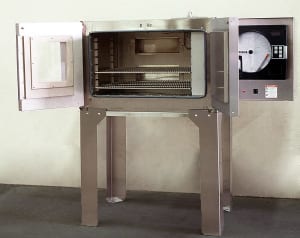
The oven has 3” insulated walls, a Type 304, 2B finish stainless steel interior and a #4 brushed finish stainless steel exterior. Two 13” x 4” access slots are equipped with insulated covers on the rear wall of the oven. An 8” x 10” double-pane Pyrex window is used for viewing the oven chamber. An interior oven light is also provided.
Controls onboard No. 983 include recording and programming temperature controllers and a recirculating blower for this oven.
For more information, please contact: THE GRIEVE CORPORATION, 500 Hart
Road, Round Lake, Illinois 60073-2835 USA. Phone: (847) 546-8225. Fax: (847) 546-
9210. Web: www.grievecorp.com. Email: sales@grievecorp.com. Attention: Frank
Calabrese.
-0-
Photo enclosed
Argus Subsea uses hydraulic rod locks from AME to secure underwater oilfield trees at 5000-6000’ depths to 3000 psi and 50,000 pounds of axial holding
Argus Subsea produces its AZ-10 fully concentric, vertical mono-bore subsea tree design for rapid field development. Originally designed for low net present value (NPV), marginal and smaller fields, where the capital investment containment is critical and the need exists for off-the-shelf hardware, the AZ-10 can be run on any rig, regardless of moonpool size or accessibility through a V-door or port side. Essentially, according to Earl Broussard, the company’s director of sales & marketing, “Anywhere a rig can power a BOP, the AZ-10 can operate effectively. And, being a standard horizontal tree design with a universal tubing hanger system that runs in any 18-3/4”, 10,000 or 15,000 psi wellhead, with a concentric design for all downhole and tubing hanger-to-tree interface, it can be quickly put into service.” In fact, the company’s literature boasts a typical reduction in time to first oil of fifteen months, with lower CAPEX and OPEX costs, less drilling and wellhead completion cost, plus reduced third-party cost.
The AZ-10 is currently rated at 10,000 psi working pressure and 6000’ water depth and is designed to the standards of API 17D, API 6A, PR2, NACE MR0175 and AV1 PR-2 USV. The unit weighs approximately 50,000 pounds and is light enough to be handled safely with rig cranes and easily transported to the moonpool. The AZ-10 can be deployed through any Generation-2 semi-submersible or newer generation rig’s moon pool. A much simpler design than most horizontal or vertical trees, the AZ-10 requires only five running tools versus 20-30 typically found on comparable subsea tree systems. The units are designed for 20 years of service life in production, injection or well test operations.
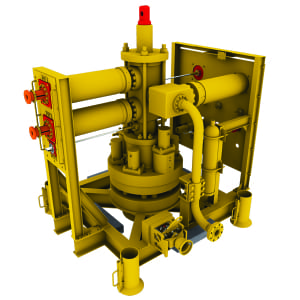
AMLOK rod lock highlighted on tree. Each rod lock operates to 3000 psi and provides 50,000 pounds of axial holding force at depths of 5000-6000’. Special construction, porting and heat treatment were utilized in the manufacture of these devices.
The hanger system operates on a lock and seal system that uses mechanical and hydraulic sealing within the tubing hanger. A key component designed into the AZ-10 is the AMLOK® hydraulic rod lock, provided by Advanced Machine & Engineering (AME) of Rockford, Illinois, a designer and builder of various rod locks for both hydraulic and pneumatic holding, in the event of a power loss. AME rod locks are typically found on all types of off-highway and construction equipment, as well as materials handling devices, machine tools and elsewhere, used to secure a cylinder rod in place to prevent further motion.
For the application on the Argus Subsea trees, according to Shane Hatfield, AME sales manager, several challenges were apparent and a few were not. The obvious obstacles were the depth and the pressures involved. The maximum load was to be 3000 psi and the axial holding force approximately 50,000 pounds at typical depths in the 5000-6000’ range. To address these issues, AME engineered the rod locks from 4140 steel with electroless nickel plating and a specially formulated two-part epoxy to create a completely sealed unit. Marine grade lubricant was used. “Those were the easy parts,” muses Hatfield.
With the external sealing system of the AZ-10 and the wide variety of connections involved, the construction of the rod lock also needed to accommodate the unique challenges of force over distance in a wide window of installation conditions. Since the customer was very cost-sensitive, it was necessary for AME engineers to create a one-size-works-for-all unit and this presented considerable application engineering challenges. “This was the hard part,” recalls Hatfield.
Working with Chance Burton, the driving force behind the original engineering effort at Azura, the predecessor company to Argus, Hatfield and his team demonstrated AMLOK rod locks as the only design that worked immediately over the entire range of performance scenarios. 1500 psi release and 3000 psi compressive were needed to satisfy all conditions and the AME engineers successfully satisfied these criteria. Key factors in the success of the AMLOK design here are the special porting and autoclave treatment used.
After an initial order of 10 units (2-4 used per tree), the business has remained steady, according to Hatfield. These rod locks have been used successfully on numerous installations of the AZ-10, where the connections to numerous wellhead equipment brands have varied considerably.
As the attached diagrams demonstrate, AME rod locks are actuated by a spring/collet mechanism upon loss of hydraulic power and unclamped by the restored pressure. They are built to accomplish a mechanical locking, holding a cylinder rod or machine shaft in position, up to the rated load, until power is restored and the locking mechanism released.
For more information on the subsea trees referenced in this story, please contact:
ARGUS SUBSEA 5510 Clara Road Houston, TX 77041 Phone: 713-983-7222 Fax: 713-983-7007 Email: info@argussubsea.com Web: www.argussubsea.com Attention: Earl Broussard, Director of Sales & Marketing
For more information on the rod locks referenced in this story, please contact:
Shane Hatfield, Sales Manager
ADVANCED MACHINE & ENGINEERING CO.
2500 Latham Street Rockford, IL 61103
Toll-Free: 800-225-4263
Phone: 815-962-6076
Fax: 815-962-6483
Email: shane@ame.com
Web: www.ame.com
AME-Advanced Machine & Engineering Co., is a manufacturer located in Rockford, Ill., serving the Machine Tool Industry with precision components and accessories, including spindle interface components, workholding devices and, through our sister company, Hennig, machine enclosures, chip removal and filtration systems. The Fluid Power – Safety markets are served with cylinder rod locks and Safety Catcher devices; and the Production Saw market with our AmSaw carbide saw machines and Speedcut blade products. AME has manufacturing partners and service centers around the world and across the U.S. To learn more, visit www.ame.com.
Hennig, Inc. designs and produces custom machine protection and chip/coolant management products for state-of-the-art machine tools. Hennig products are designed to protect against corrosion, debris and common workplace contaminants. Manufacturing facilities are located in the U.S., Germany, France, Czech Republic, Brazil, India, Japan, China and South Korea. Repair centers are located in Machesney Park, IL; Chandler, OK; Livonia, MI; Blue Ash, OH; Mexico City, Mexico; and Saltillo, Mexico. To learn more, visit www.hennigworldwide.com.
Please direct all inquiries from this article to:
Tim Waterman
ADVANCED MACHINE & ENGINEERING CO.
2500 Latham St.
Rockford, IL 61103
Phone: 815-316-5277
Fax: 815-962-6483
E-mail: info@ame.com
Connect with AME online:
Global leader in carbide sawing systems acquired by leading machine tool component and carbide saw machine manufacturer
Advanced Machine & Engineering (AME), the Rockford, Illinois-based manufacturer of various machine tool components and auxiliary equipment, today announced the asset purchase of the Metalcut Carbide Saw Division of Centro-Metalcut, also of Rockford and a longtime global industry leader in the design and manufacture of heavy-duty carbide sawing systems for the metalcutting industries.
AME is also a leading global manufacturer of carbide sawing systems, under its popular AMSAW® brand name. AMSAW systems are found in forge, metalcasting, service center and primary producer operations, anywhere large or continuous sawing is performed. The acquisition of the Metalcut carbide saw line represents a substantial expansion of the company’s capabilities in the world market.
This purchase will transfer the complete sawing machine technologies, engineering data, inventory, spare parts and service operations for all Metalcut carbide saws to AME. Steve Swanson, the business unit manager for the carbide saw machine division of AME, will assume oversight responsibility for the Metalcut product line, allowing a seamless transition for all existing customers and immediate access to the Metalcut carbide saw line for all new AME accounts. AME has worldwide sales and service locations already in place to accommodate all customer requirements, according to Greg Champion, vice president of sales & marketing for the company.
Centro-Metalcut will continue to manufacture and market all other product lines in its offering, including hot and cold abrasive saws, conditioning grinders and materials handling equipment.
Dietmar Goellner, AME president and CEO, and Danny Pearse, CEO of Centro-Metalcut, agreed to the purchase terms on September 24, 2010.
For more information, please contact:
Tim Waterman
ADVANCED MACHINE & ENGINEERING CO.
2500 Latham St.
Rockford, IL 61103
Phone: 815-316-5277
Fax: 815-962-6483
E-mail: info@ame.com
Connect with AME online:
Advanced Machine & Engineering Co., is a manufacturer located in Rockford, Ill., serving the Machine Tool Industry with precision components and accessories, including spindle interface components, workholding devices, and, through our sister company, Hennig, machine enclosures, chip removal and filtration systems. The Fluid Power – Safety markets are served with cylinder rod locks and safety catcher devices; and the Production Saw market with our AmSaw carbide saw machines and Speedcut blade products. AME has manufacturing partners and customers around the world and across the U.S. To learn more, visit www.ame.com.
Hennig, Inc. designs and produces custom machine protection and chip/coolant management products for state-of-the-art machine tools. Hennig products are designed to protect against corrosion, debris and common workplace contaminants. Manufacturing facilities are located in the U.S., Germany, France, Czech Republic, Brazil, India, Japan, China and South Korea. Repair centers are located in Machesney Park, IL; Chandler, OK; Livonia, MI; Blue Ash, OH; Mexico City, Mexico; and Saltillo, Mexico. To learn more, visit www.hennigworldwide.com.
Continue reading